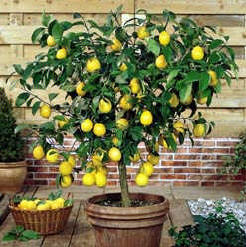Sue Williams
Adams County Master Gardener
 Outside, cold and blustery weather returned to Adams County after several days of spring like temperatures. Inside, fragrant blossoms and shiny green leaves on our
greenhouse window plants and dwarf citrus trees provide an antidote to the whipping winds. Nothing makes a room smell more like spring than the soft lemony scent of the blossoms of a Meyer lemon tree.
Outside, cold and blustery weather returned to Adams County after several days of spring like temperatures. Inside, fragrant blossoms and shiny green leaves on our
greenhouse window plants and dwarf citrus trees provide an antidote to the whipping winds. Nothing makes a room smell more like spring than the soft lemony scent of the blossoms of a Meyer lemon tree.
A Bit of History
Throughout history, common gardeners and kings have grown citrus indoors and out. Appreciated for centuries around the world, the "limung," as it was called, is thought to have originated in the foothills of Kashmir, from where it migrated to China
more than 3,000 years ago. The Romans grew lemon trees in greenhouses with mica windows. The Arabs, Spaniards, and Dutch planted lemon trees along their travel routes to protect themselves from scurvy. France's King Louis XIV so loved the scent of orange blossoms that he
had the first orangerie built to have the trees bloom year round. Citrus seeds were brought to the New World in the 1490's, and by 1565, Spanish explorers had established orange orchards in Florida where they are still a major industry. Today, Italy remains the largest
grower of lemons in the world.
Citrus from Seed?
|

Citrus lemon 'Improved Meyer'
|
Children often wonder if they can grow a tree from the seeds found inside oranges, tangerines, oranges, lemons, and grapefruit. Yes, as long as the seed is not damaged, the odds are good that it will produce a plant. But, you need to know that
seedlings experience a very long period before they flower and bear fruit- perhaps seven years or more! Most citrus grown for indoor home use are dwarf varieties that are either cuttings grown or grafted on a dwarfing rootstock. By using cuttings or grafts from mature
trees, a plant is produced that is ready to begin fruiting right away.
According to Leslie Land, garden writer for the New York Times, if you are serious about citrus, consider trees that are sold for pot culture like the Meyer lemon and other dwarf varieties. The "improved" Meyer Lemon tree is the most popular of all
citrus trees, easy to grow, prolific in its blooming and fruiting, and a favorite of chefs for gourmet recipes. If you are looking for an unusual plant to give as a gift, consider a dwarf kumquat, lemon, tangerine, or a handsome calamondin orange with small white blooms
that perfume the house.
Citrus Varieties That Thrive Indoors
- Calamondin- The plants have wide, lush leaves and bright orange fruit that resemble small tangerines.
- Kaffir lime- A lime tree that also boasts delicious leaves used in cooking Southeast Asian dishes.
- Meiwa kumquat- These kumquats are sweet, round, and perfect for fresh eating.
- Meyer lemon- The lemons are deep yellow and the trees will bear fruit heavily.
Caring for Indoor Citrus
Here is a brief guide for keeping your indoor citrus plants happy and healthy:
- Location: Make sure your plants receive five to six hours of sunlight. Set your tree in a southern exposure, if possible, or supplement the light by using 40 watt fluorescent shop lights above the plants.
- Fertilizer: Use an acidic fertilizer during the plant's active growing season in late winter, June and August. Use a high-nitrogen-low phosphorus food (20-10-10) or one specifically for citrus every time you water.
- Water: Your pot must have good drainage as you water every few days. Mist the leaves and give your tree a shower occasionally.
- Humidity: Homes in winter have drier air, so try a tray of pebbles under the pot.
With the right care and a little luck, your own personal citrus grove will bring you great enjoyment and last for years. Just imagine strolling into your living room or kitchen to pluck a lemon for use in your favorite lemon bar recipe or limes for
Tex-Mex dressing. In our present cold climate (getting warmer every day), you can order dwarf citrus trees now from mail-order nurseries and local garden centers a bit later in the spring.
Read other articles on growing fruits, herbs, and vegetables
Read other articles about tree care